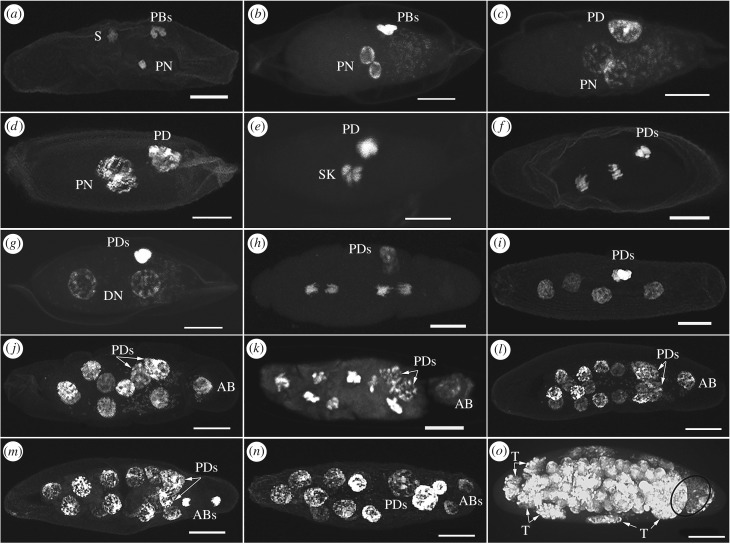Figure 1.
Normal embryo development of E. suzannae in compatible crosses. (b,c,g,j,l,m,n,o) Eggs of infected females mated with infected males, containing the bacterial endosymbiont Cardinium (bright small dots). (a,d,e,f,h,i,k) Eggs of cured females mated with cured males. (a) Fertilized egg at the end of meiosis, containing the female pronucleus (PN) and three polar bodies (PBs) and the peripheral sperm nucleus (S). (b) Female and male pronuclei approaching at interphase, three PBs. (c,d) Apposition of female and male pronuclei at prophase of the first cleavage division (CD), one polar body derivative (PD) is occurring. (e) First CD: synkaryon (SK) at the end of metaphase–early anaphase with four groups of chromosomes, a pair from each pronucleus. (f) First CD, end of anaphase and two PDs. (g) First two daughter nuclei (DN) and two PDs. (h) Anaphase of second CD and two PDs. (i) At the end of second CD, there are four DN. (j) End of third CD: eight DN of which one migrating to the pole close to the two PDs forms the apical blastomere (AB). (k) Fourth CD: seven DN in metaphase while the asynchronous AB is still in interphase, the two PDs polyploidize. (l) End of fourth CD: 14 DN, 1 AB in prophase and two PDs. (m) End of fourth CD: 14 DN, the AB at the end of anaphase, two PDs. (n) End of fourth CD: 14 DN, two ABs and two PDs. (o) Embryo after 24 h surrounded by stretched polyploid nuclei (teratocytes: T) forming the extra-embryonic membrane and with a high density of Cardinium bacteria near the right (posterior) pole in the black circle.

